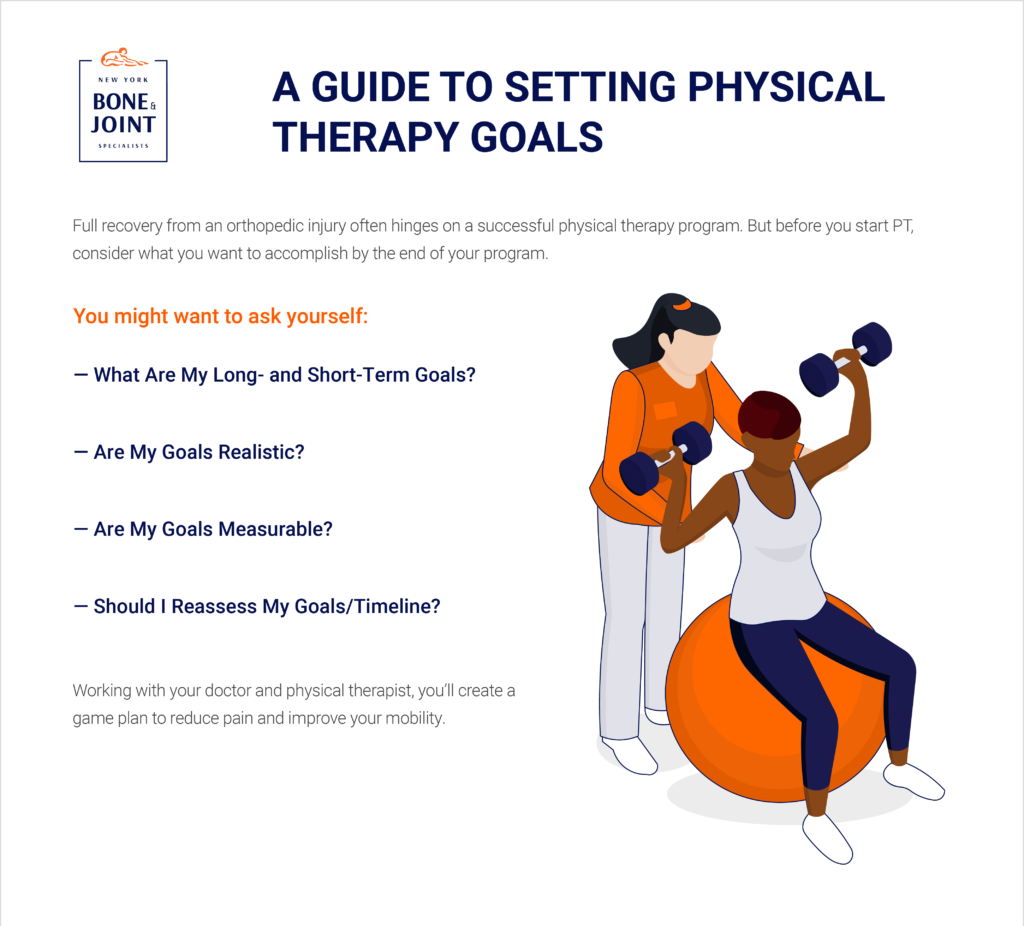When starting a physical therapy program, it’s helpful to set achievable goals to keep you motivated and mark your progress.
Full recovery from an orthopedic injury often hinges on a successful physical therapy program. Working with your doctor and physical therapist, you’ll create a game plan to reduce pain and improve your mobility.
But how do you effectively measure your progress? Begin by setting measurable and realistic goals.

A Guide to Setting Physical Therapy Goals
Before you start physical therapy, consider what you want to accomplish by the end of your program. You might want to ask yourself:
What Are My Long- and Short-Term Goals?
Every physical therapy program includes both long- and short-term goals. Examples of long-term goals would be:
- Returning to work within three months
- Playing sports again
- Walking a mile without assistance in a month
- Performing routine daily tasks (bathing, cooking, cleaning, etc.) without help
- Reducing pain
- Increasing joint mobility
To reach those long-term goals, you and your physical therapist will target shorter-term milestones. For instance, before you walk a mile unassisted, you can first aim to walk 100 yards without assistance. Or, if your long-term goal is pain reduction, you could measure your short-term progress by not taking pain medications for a day, then lengthen it to two days, and so on until the ultimate goal of no or very minimal discomfort is attained.
Reaching short-term goals also deepens your motivation. As you pass each goal, you’re motivated to move on to the next one.
Are My Goals Realistic?
Your doctor and physical therapist will evaluate your goals to help determine if they are realistic and attainable. In some cases, you may not be able to regain full function of a joint, but you can lessen or eliminate pain and increase your overall mobility. Whatever the goal, your doctor and physical therapist should communicate in clear terms how your goals can be successfully achieved.
Are My Goals Measurable?
Every goal you set must be measurable. The more specific and measurable the goal, the more likely you are to hit the mark. Walking a specified distance is an easily quantifiable goal. Although more subjective, pain reduction is a goal that can be evaluated by how you feel as you advance through your program.
Should I Reassess My Goals/Timeline?
Goals are not set in stone — in fact, as you progress, you and your physical therapist may want to adjust your goals based on your day-to-day status. Your original timeline could be shortened or lengthened depending how far you’ve progressed. You may need to hold off on returning to sports for another month, or you might reach your goals sooner. Your physical therapist may need to add or eliminate exercises, as well, to help you reach your objectives.
When your program ends, you’ll want to continue your progress and maintain your recovery at home. Your physical therapist will help you develop a plan with at-home exercises and daily living techniques to keep you healthy and pain-free.
What’s Your Physical Therapy Plan?
At New York Bone & Joint Specialists, we have a team of experienced surgeons, orthopedists, and physical therapists to guide you toward a full recovery. We’re experienced in treating orthopedic injuries with surgery, physical therapy, or a combination of the two. Contact us today to set up a consultation.




